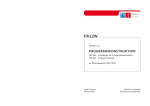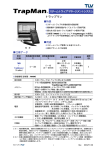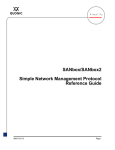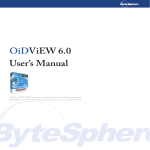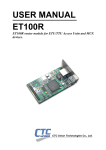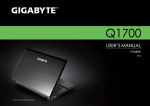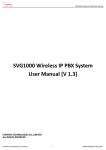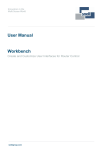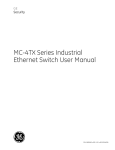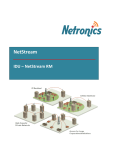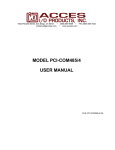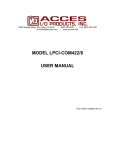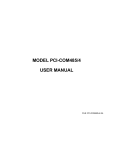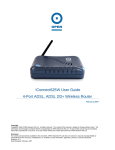Download Manual - Yacoub Automation GmbH
Transcript
etherRAIL Managed Switches User Manual SM 4TX2FX SM 4TX SM 5TX M12 Page 1 of 45 etherRAIL Managed Switches User Manual Hardware and Software for etherRAIL managed Switches This User manual describes the following switches: • SM 4TX • SM 4TX1FX • SM 4TX2FX • SM 5TX M12 Version Date Comment Author 1.3 03. February 2014 Revision Dr. L. Neumann 1.2 01. July 2013 Translation and supplement Felix Hoffmann 1.1 2. March 2009 Restructuring and supplement Reinhard Meyer 1.0 16.October 2003 Initial Version Philipp Page 2 of 45 Please note the following To ensure the safe use of our products, we encourage you to read this manual carefully. You will find all the necessary information for installing and operating the etherRAIL managed switches. If you have any further questions or in need of help, please contact us or our experts (see contact list). The following notes provide information on the use of this manual. • Who should use this manual: The use of the products described in this manual is solely permitted for qualified technical personnel who are familiar with electronic applications and standards; in particular, this concerns relevant security concepts. The Yacoub Automation GmbH takes no liability for damage or improper action on their products or the products of third parties, which have emerged from disregard of information contained in this manual. • Legend of symbols used: - The warning symbol refers to an instruction that, if not followed properly, can lead to hard- and software damage as well as to damage of people. - The memory symbol refers to instructions for the correct configuration of the device. • Contact: Tell us what you think. We are always keen to improve our products and documentation. If you have any questions or comments, please contact us: Yacoub Automation GmbH Gustav-Meyer-Allee 25, D-13355 Berlin Fon: +49 30 34 99 834 - 0 Fax: +49 30 34 99 834 - 55 Page 3 of 45 Terms and conditions of the technical documentation • The Yacoub Automation GmbH reserves the right to change the technical documentation and the products described in this documentation without a modify notice, correct or improve, as far as is reasonable for the user. This also applies to modifications in the technical progress. The preservation of technical documentation does not imply further duty of information on Yacoub Automation GmbH of any modification of the products or their documentation. • Any otherwise agreement is only valid if it has been expressly confirmed in writing by the Yacoub Automation GmbH. Please note that the included documents are exclusively productspecific nature and that you are responsible to check over the suitability and intended use of the products in your specific application, in particular with regard to observing the applicable standards and laws. • Although Yacoub Automation works with the necessary care to document the product features and the technical state of the art correctly, the documents may contain technical inaccuracies or typographical errors. The Yacoub Automation GmbH makes no warranties as to the accuracy or completeness of the information. All information given in the technical documentation is provided without any express, implied or other warranty. They contain no agreements made, do not describe any fair marketable quality, and does not make any express warranty or guarantees regarding the suitability for a particular purpose. • The Yacoub Automation GmbH assumes no liability or responsibility for any errors or omissions in the content of the technical documentation. The foregoing limitations of liability and exclusions do not apply if liability is mandatorily imperative, eg, under the Product Liability Act, in case of intent, gross negligence and injury of life, body or to personal health or injury of material contractual obligations. • The claim for damages by the breach of fundamental contractual obligations is limited to the contract-typical, foreseeable damage if there is no willful misconduct or gross negligence or injury to Life, body or personal. A change in the burden of proof to the detriment of the user is not connected with this regulation. Page 4 of 45 Table of Contents 1. PRODUCT OVERVIEW .....................................................................................................................7 1.1. GENERAL DESCRIPTION............................................................................................................................... 7 1.2. INTERFACES AND DISPLAYS .......................................................................................................................... 9 1.2.1. Ethernet Ports ..................................................................................................................... 9 1.2.2. Display of the Transmission Status ................................................................................... 10 1.2.3. Power-ON Display ............................................................................................................. 10 2. IMPLEMENTING THE SWITCH .......................................................................................................11 2.1. INSTALLATION ......................................................................................................................................... 11 2.1.1. Assembly and Disassembly of the Switch ......................................................................... 11 2.1.2. Power Supply ..................................................................................................................... 12 2.1.3. Alarm Contact .................................................................................................................... 13 2.1.4. Schnittstelle für externe Management ............................................................................. 13 2.2. POWER UP THE SWITCH ........................................................................................................................... 13 2.2.1. Default Settings ................................................................................................................ 13 2.2.2. Assigning IP Addresses ...................................................................................................... 14 2.2.3. Web-based Configuration ................................................................................................. 14 3. FUNCTIONS ..................................................................................................................................15 3.1. BASIC SETTINGS ...................................................................................................................................... 15 3.1.1. Protocol............................................................................................................................. 15 3.1.2. Media Access Controller (MAC) ........................................................................................ 16 3.1.3. Frame-Switching ............................................................................................................... 17 3.2. ADVANCED FUNCTIONALITY ....................................................................................................................... 17 3.2.1. Traffic Control in the Network .......................................................................................... 18 3.2.2. Operational and Data Security ......................................................................................... 18 3.2.3. Diagnosis .......................................................................................................................... 20 4. SWITCH MANAGEMENT ...............................................................................................................20 4.1. SIMPLE NETWORK MANAGEMENT PROTOCOL (SMNP) ............................................................................... 20 4.1.1. SNMP Protocol Stack ......................................................................................................... 20 4.1.2. Trap ................................................................................................................................... 21 4.1.3. Management Information Base (MIB) .............................................................................. 22 4.1.4. Integrated MIB-Engine...................................................................................................... 22 4.2. WEB BASED CONFIGURATION .................................................................................................................... 25 4.2.1. General Instruction ........................................................................................................... 25 4.2.2. Device Information ........................................................................................................... 25 4.2.3. Serial Port ......................................................................................................................... 26 4.2.4. General Settings................................................................................................................ 27 4.2.5. Switch Station ................................................................................................................... 31 A. EASYNMS – NETWORK MANAGEMENT TOOL ...............................................................................37 A.1. A.2. A.3. A.4. OVERVIEW ............................................................................................................................................. 37 CONTENT OF THE CD ............................................................................................................................... 37 SYSTEM REQUIREMENTS ........................................................................................................................... 37 INSTALLATION AND PROGRAM INITIALIZATION ............................................................................................... 37 A.4.1. Microsoft Windows ........................................................................................................... 37 A.4.2. GNU / Linux ....................................................................................................................... 38 Page 5 of 45 A.5. PROGRAM DESCRIPTION ........................................................................................................................... 38 A.5.1. Assembly of the graphical user interface .......................................................................... 38 A.5.2. First Start of Program ....................................................................................................... 39 A.5.3. Add New Device in the Network Tree ............................................................................... 39 A.5.4. Display of the Object Variables ......................................................................................... 40 A.5.5. Manipulation of the Object Variables ............................................................................... 40 A.5.6. MIB-Files ........................................................................................................................... 41 A.5.7. Project Settings ................................................................................................................. 41 B. TECHNICAL DATA .........................................................................................................................42 C. PRIVATE MIB ................................................................................................................................45 Page 6 of 45 1. Product Overview 1.1. General Description The etherRAIL product line is designed for use in industrial environments. The switches have TX ports for lines in twisted pair configuration, and optionally via FX ports for cables in fiber optic design. The FX ports enable network connections between widely extended network segments and offer greater insensitivity to electromagnetic interference. The SM series offers the user a cost-effective network expansion in a small enclosure with low power consumption. SM 4TX2FX SM 4TX 5TX M12 The 'plug and play' concept makes the device easy to use. The DIN rail mounting and a device width of only 45mm ensure an easy expansion and exchange option. The terms of protection degree, IP 20, are met. Two LED indicators signal the user for each TX and FX port an existing connection to the link partner and information about the traffic. The series was expanded to IP67 switch SM 5TX M12, which is suitable for the application with harsh environmental conditions. It is designed for direct mounting without a control cabinet. IP67 protection allows use in wet, dirty and dusty industrial environment even at extreme temperatures. The small dimensions (L: 105mm x W: 60mm x H: 30mm) require only a small footprint in machinery and equipment. Direct mounting as well as "plug-andplay" concept enables a fast and inexpensive construction. The 5-TX Ethernet connections are made via M12 connector with IP67 protection rating. Page 7 of 45 User Benefits • Perfect adaptation to the application by variable equipment of TX/FX- ports • Simplified configuration and extension of the network, • Automatic detection of data transmission rate to the RJ45 ports (10/100 Mbit / s), • ensuring increased network availability using RSTP in the use of redundant transmission paths in different network topologies and meshed structures, Device Models SM 4TX SM 6TX 4 RJ45-Ports 6 RJ45-Ports SM 4TX1FX 4 RJ45-Ports, 1 FX-Port (ST/SC-Connection) with Multi Mode (MM) or Single Mode (SM) SM 4TX2FX 4 RJ45-Ports, 2 FX-Ports (ST/SC-Connection) with Multi Mode (MM) or Single Mode (SM) SM 5TX M12 5 TX-Ports with M12-Connection Front View Power Supply SDCards Power Supply Status Power LED RJ45Ports FXPorts TX-Ports M12 Status Power LED SM 4TX2FX , SM 4TX SM 5TX M12 Page 8 of 45 1.2. Interfaces and Displays This section describes the Ethernet functionality on its physical level. 1.2.1. Ethernet Ports The switch features depending on the type IEEE 802.3 10BASE-T and 100BASE-TX/FX independent Ethernet interfaces. The TX ports are designed for twisted pair cable (TP) cable with RJ45 connectors. The FX ports are designed for fiber optic cable with connectors SC/ST- or alternatively for plastic optical cables as a direct connector. Only TP cable with an impedance of 100 ohms can be used. The pin assignment of the RJ45 connector is shown in Figure 1.1. Pins 1 and 2 transmit the received data, while pins 3 and 6 transmit the data to be sent. The other pins are not used for Ethernet transmission. The pin assignments for received and sent data can be interchanged, since the switch has a crossover functionality for each port. Figure 1.1.: Pin assignment of the Ethernet ports RJ45 The pair assignment for the receive line has to be properly connected. The polarity of the switched RD + and RD is automatically reversed! The inputs and outputs of the data lines are electrically isolated by an inductive coupler. The Ethernet ports 1-5 of IP67 switch are in accordance with the IEEE802.3 standard and have 4conductor shielded and d-coded M12 connectors with the following assignment: Pin 1: TX+ Pin 2: RX+ Pin 3: TXPin 4: RXFigure 1.2.: Pin assignment of the Ethernet ports M12 Page 9 of 45 1.2.2. Display of the Transmission Status Each port has two LEDs near the Ethernet ports on the input side, which show the port status. The meaning of the LEDs is described in the following table 1.1. LED Function Status Description Yellow Active Blink Off Transmit or receive activity No transmit or receive activity On Transmit (Link-up) Off No transmit (Link-down) Green Link Chart 1.1.: Display of the transmission status Each of the five Ethernet ports on the IP67 switches has a green signaling LED with the following displays: LED Green Status Out On blink Description No connection Connection, no transmit or receive activity Transmit or receive activity 1.2.3. Power-ON Display Two green LEDs above the Ethernet ports show the functionality of the two power supplies. Both power supplies are decoupled via a diode. The IP67 switch contains a power LED, which is green, red or orange. Green corresponds of startup, orange / green blinking means boot and red corresponds error. Page 10 of 45 2. Implementing the Switch This chapter explains how to start the operating condition and the initial boot of the software after turning on the switch. 2.1. Installation When mounting and dismounting of the switch must be disconnected from the power supply! 2.1.1. Assembly and Disassembly of the Switch The device (except SM 5TX M12) is designed for installation in the mounting rail according to DIN EN 50 022. To avoid contact problems are only clean, rust-free rails to be used. The device is automatically grounded by the snap onto the DIN rail, if the carrier rail is grounded. The grounding must be done in low impedance. A missing grounding can cause a malfunction. The DIN rail must be mounted horizontally on a vertical surface, so that the units for optimal heat dissipation sit upright. Note: The free space above and below the mounted devices must be at least 50 mm for optimum heat dissipation. Instructions for mounting the device see Figure 2.1: 1. Place the device on top of the DIN rail (A). The upper part of the clamp the must be hooked onto the edge of the DIN rail. Press the device to the front towards the mounting surface (B). 2. After the device has been snapped, check if it is fixed securely on the DIN rail. Check that the locking tabs are facing upwards when locked into place. 3. In an extension insert the second device, as described above, next to the first device. 4. For a higher stability both devices can be fixed by a clamp at the corners of the device. Figure 2.1.: Mounting a Switch Page 11 of 45 Dismounting a device see figure 2.2.: 1. 2. If the brackets are fixed, undo fixation first. If several devices are assembled together, loosen the devices from one another along the rail. 3. Pull the locking tabs downwards with a suitable tool (eg screwdriver). The two latches remain in the disengaged state. 4. Swing the bottom of the device slightly away from the DIN rail (A). 5. Then lift the device up and away from the DIN rail (B). Figure 2.2.: Dismounting a Switch 2.1.2. Power Supply Figure 2.3.: Power Supply via COMBICON An integrated power supply unit regulates the voltage required for the device. The external supply voltage of 24 V is applied across the four-pin COMBICON connector on the device, see Figure 2.4. There is a polarity reversal in the case of applying the wrong polarity. It can tune cable from 2 2 0.2mm . . . up to 2.5mm (AWG 24 ... AWG 14). To ensure a good contact, the cable ends must be stripped about 10 mm. The power supply of IP67 switch 5TX M12 made together with the serial communication via a 5-pin A-coded M12 connector: Pin Nr. Bezeichnung Description 1 VCC Positive Terminal of the Supply Voltage 2 0V Negative Terminal of the Supply Voltage 3 TX RS232 Interface, Transmit Line 4 RX RS232 Interface, Receive Line 5 GND RS232 Interface, Signal Ground Figure 2.4.: Power Supply via M12 Connector Page 12 of 45 2.1.3. Alarm Contact In case of a sudden power failure during operation, the switches (except SM 5TX M12) can give an alarm. To avoid that the switch gives a false alarm, the alarm contact can be disabled via the web interface (see Section 4.2.5). Figure 2.5.: Schematic diagram alarm contact 2.1.4. Schnittstelle für externe Management Every Device contains a USB or RS232 (SM 5TX M12) interface. 2.2. Power up the Switch After an external power supply is present on the switch, the switch firmware is automatically loaded. When the boot process is complete, the switch is operational. 2.2.1. Default Settings The delivery status of the switch and the status after a reboot contain the following settings: • Port Configuration: – TX- and FX-Ports are configured in 100 MBit/s full duplex mode. – Auto-Negotiation and Auto-Crossover are activated for each TX-Port. • IP-Configuration: – IP-Address, Subnet and Gateway-Address will be set to 0.0.0.0 . – The default address mechanism is BootP. • Web Based Management: – If the web server is enabled, the password is ’private’. – SNMP is activated, no information about network devices, it is stored yet. – RSTP and Multicast Filtering are deactivated. To increase operational safety, we recommend that you change the password when the switch is set to the operating mode, see chapter 4.2. Page 13 of 45 2.2.2. Assigning IP Addresses Figure 2.6.: Flowchart Assigning IP Addresses By default, the switch receives its IP configuration via BootP, but there is also the possibility of addressing mechanism via the web interface one-note, see Section 4.2.4. After the switch is connected to the network, all addresses of the connected devices are stored. The process in the switch during initial assignment of an IP-address is illustrated in Figure 2.6. 2.2.3. Web-based Configuration The web server on the switch is enabled by default. To access the website of the switch, perform the following steps: 1. Ensure that the switch has started and that it is connected to the host via Ethernet. 2. Open a browser of your choice. 3. Enter the IP address of the switch in the address field, e.g., http://192.168.2.110. 4. In successful cases you should see the following web page of the switch (see figure 2.7). Page 14 of 45 Figure 2.7.: Home page of the switch web server It could be that you need to adjust the IP configuration of the calling host to reach the web server with the switch. Also pay attention to existing firewalls that may block the access. 3. Functions 3.1. Basic Settings This chapter describes the basic functionality of the switch. To learn more about the management functions of the switch, we recommend that you go to chapter 4. 3.1.1. Protocol • Data Transfer: The Ethernet Ports of the etherRAIL SM-Series support the following Ethernet-Protocols due to the IEEE-802.2- Specification. – 100BASE-TX/FX Full Duplex 100 MBit/s, – 100BASE-TX Half Duplex 100 MBit/s, – 10BASE-T Full Duplex 10 MBit/s, – 10BASE-T Half Duplex 10 MBit/s. The settings of the protocols are fixed as soon as the switch is powered up. The transfer rate can be set separately for each port, while the settings for duplex mode apply to all ports. In addition, auto-negotiation can be separately set for each port. The switch has mechanisms to select the protocol with the best performance between the link partners: Page 15 of 45 • Auto-Negotiation und Auto-Sensing: Auto-negotiation allows the exchange of protocol settings between the two link partners. If auto-negotiation is accepted by the link partner, the switch automatically selects the protocol with the highest performance. If auto-negotiation is not possible, the switch tries to determine the link-mode with auto-sensing passively. • Auto-Crossover: Auto-Crossover-The switch automatically detects whether the received data arrive on line 12 or line 36 which leads - if necessary - to a crossover (see Figure 1.1). The automatic crossover detection allows you to use any Ethernet cable. With these settings, the ports can be configured individually via the web browser. See Section 4.2.5. 3.1.2. Media Access Controller (MAC) The Ethernet port perform all functions of the IEEE 802.3 specification for each separately applied MAC; e.g. frame formatting, frame stripping, CRC checking, CSMA / CD Enforcement, Collision handling. • Review of incoming packets: All received packets are checked for validity. Packets, with CRC errors or a packet length less than 64 bytes or longer than 1536 bytes, are discarded. Only valid packets are forwarded to the switching fabric unit (SFU), see section 3.1.3. • Sending packets: In full duplex mode, the transmission line is always available, but it can happen in half-duplex mode, that the transmission line is blocked. In this case the transmitter stays ready to transmit. Once the line is restored, the transmitter starts sending a 56-bit preamble and an 8-byte start-of-frame delimiter followed by the payload data. The minimum packet spacing is 96 bits. • Preamble Recovery: Due to bit- synchronization it is possible to receive packets whose length of the preamble is less than 56 bits. In this case, the preamble will be automatically completed by the switch to 56 bits. • Collision detection: During transmission, the switch monitors the collision signal for half-duplex mode. If a collision is detected on one of the ports, the MAC sends a JAM pattern to all the connected devices to interrupt the transmission. The switch then delays the retransmission by a random amount of time, according to the backoff algorithm according to IEEE 802.3. In full duplex mode, the collision signal is ignored. Page 16 of 45 3.1.3. Frame-Switching The switch operates in store-and-forward mode. If a data packet is received, the switch analyzes the source and destination address. The switch is able to store up to 1024 MAC addresses in its address table, with a retention time of 48 seconds. • Switching Fabric Unit (SFU): The SFU receives the error-free packets from the ports for processing and forwarding to the MAC address of the destination device. The SFU has the ability to learn which packages must be forwarded to the ports. This sets the SFU on a table with the source addresses of the packets and the number of ports on which the packets are received. Using the generated table and the destination MAC addresses, the SFU can decide which packages must be sent via which port. • Address Lookup-Table (LUT): The LUT is generated by the internal lookup engine. It stores all the source addresses of incoming packets, together with the port number of the switch. Up to 4096 number address port mappings may be stored in the address table. This procedure is necessary, if a plurality of terminals is connected to a port or plurality of ports. In this case, different and independent sub networks are connected via the switch. • Find addresses: Initial for incoming packets: At first it will be searched in the lookup table for the destination address. If the destination address is provided, the number of the output ports to the output port queue manager is forwarded. After that the packet is forwarded to the appropriate output port. Packets with a multicast or broadcast address will be forwarded to all output ports, but to the input port. • Learning addresses: If the MAC address of the target device is not in the lookup table, the switch switches to the self-learning mode. The switch sends the packet to all ports in order to enable the forwarding of the packet to the correct destination device. A device responding to this packet will learn its MAC address of the SFU. The new MAC address and port are stored as an entry in the lookup table. All future packets are transmitted directly and exclusively through this port to the destination station. • Provision of addresses: the process of provision of addresses is running continuously. Each access to the lookup table is counting up the aging time of the entries. If an entry is too old because the connection is terminated at a network node or the device is disabled, it will be removed from the address table. The maximum aging or derivative time is 300 s. 3.2. Advanced Functionality In addition to the basic protocol settings of the switch has the following extended functionality. Page 17 of 45 3.2.1. Traffic Control in the Network To control of the traffic in the network, the following techniques are implemented on the Switch: • Multicast filtering, IGMP snooping and Flow Control: In order to prevent unnecessary network traffic, the switch supports multicast filtering within the LAN via IGMP. By means of IGMP snooping, the switch is able to filter out multicast frames from the network traffic and to forward separate ports to the group members. To enable multicast filtering, see Chapter 4.2.4. If the switch is in fullduplex mode, a flow-control according to IEEE 802.3x is supported. • Port mirroring: The switch supports port mirroring, to increase the data rate by multiple uses in the parallel port mode. Furthermore this feature can be used for an extensive network analysis, see section 4.2.5. 3.2.2. Operational and Data Security • Rapid Spanning Tree Protocol (RSTP): Spanning Tree Protocol (STP) is designed to react in the event of a connection loss in the network. To increase the availability of the network the data are forwarded via intact connections to the target device. There for a loop-free LAN topology with redundant paths is introduced in the network. The RSTP is a development out of the STP, with shorter times for the production of a replacement connection to the network device. The RSTP was standardized in the IEEE 802.1w specification. The following section briefly describes the operation of the RST method. The network will be transformed from a meshed topology into a tree- (spanning tree) topology. see Figure 3.1. Figure 3.1.: Spanning Tree Topology with one redundant Path. Page 18 of 45 Each network device network is named edge (device 1 and 2) or non-edge (device 3 and 4) due to its location on the network. Only the network devices that stopped forwarding data are referred to as edge. The spanning tree is generated according to the following rules: 1.1.1.1. Select the root node (Root Device): Each network device receives a single identifier with a configurable priority number. The device with the smallest id is set as rooter. If two devices get the same ID, the device with the smaller MAC address will become the rooter. 1.1.1.2. Select the optimal path to the root device: Every link in the network is provided a cost, depending on physical criteria, such as the data transmission rate. In figure 3.1. we assume the following: Costs = 1000/Data. If there is more than one path of a network device to the root node, the connection is switched to the higher cost. This connection can take over the necessary data transfer in the case of a failure. If you follow these rules, for example, the connection marked red in Figure 3.1. can be kept as a spare connection. Due to the generated network topology (spanning tree) and the application of Rule 2, each port of a network device is provided with a port status (Port Role): – Root: Forwarder port that connects the network device to the root device (enabled). – Designated: forwarder port that connects the root device with other network devices (enabled). – Backup: port forwards data to network devices via redundant connections (disabled). – Alternate: port that is not part of the tree (disabled). The building of such a spanning tree implies knowledge about the entire network. In practice, the method is implemented by means of the RST protocol. For this, the user simply selects the root device. The root device then communicates with other network devices on the Bridge Protocol Data Units (BPDUs) to exchange information on the ID of the network device and the path costs to the root device. Then the port of a network device may be located in the following states: - Discarding: The port discards all frames and does not learn MAC addresses. - Learning: The port discards all frames, and learns MAC Addresses of other network devices. - Forwarding: The port forwards all incoming frames on (operational state). When configuring RSTP among others, the following parameters can be set, see also section 4.2.5: - Hello Time: It indicates the interval in which the root device regularly informs the other network devices using a BPDU. - Maximum age of RSTP information: The root device transmits RSTP information with aging '0 'and within the ''Hello Time“-interval. If a BPDU is received by the root device, any network Page 19 of 45 device sends its own configuration message to the root device. The age of information (BPDU) is thereby increased each time by one second when the message has passed through a switch. - Forward Delay: The value of the forward delay indicates that the switch is in the waiting state to change the status of the port from 'discarding' to 'learning' and from 'learning' to 'forwarding' 3.2.3. Diagnosis The switch supports a large number of features for network diagnostics. For the configuration please refer to the section 4.2.5. • Remote Diagnostics: Information about operating status, power supply and emergency events. • Monitoring: Monitoring of Ethernet connections and power supply. • Port statistics: Statistics on transmission quality per port: total number of detected packets over or under-sized packets, fragments, drop events, CRC errors, and collisions. • Capacity utilization: Utilization of the switch per port, total running time, the time of the last measurement, measurement intervals. 4. Switch Management The management unit of the switch creates an IP node that has its own IP and MAC address. This creates the opportunity to manage the switch via Ethernet using the Simple Network Management Protocol (SNMP). The management information is then stored on the Switch in the Management Information Base (MIB), see Figure 4.3. The MIB complies with an abstract tree that was specified for all network devices. The switch implements only a necessary subset of this tree. 4.1. Simple Network Management Protocol (SMNP) The SNMP is a protocol used to configure and monitor network devices over the Ethernet network. Using the provided software easyNMS - described in Appendix A - the switch configures and monitors the network via SNMP. 4.1.1. SNMP Protocol Stack The switch supports SNMP versions 1 and 2. Version 1 consists of the following SNMP commands, see also Figure 4.1: • Trap: Informs the management station about a relevant event on the switch, • GetRequest: request to the management agent for a value • GetNextRequest: A Walkthrough of the entire management information, offered by the management agent • SetRequest: set a value in the management information of the agent (for example, to configure a Page 20 of 45 device) • GetResponse: The reply of the Management Agent on a GetRequest, GetNextRequest, SetRequest or the management station. Figure 4.1.: Case-diagram of all SNMPv1 Supported Commands 4.1.2. Trap A trap is sent from the switch to the SNMP manager to indicate that an event has been detected by the switch. The switch detects the following events: Trap Description coldStart Sent after each cold start linkDown Sent when a connection is inactive linkUp Sent when a connection is activated enterpriseSpecific Sending in a freely configurable event Table 4.1.: Traps The cold start trap is always sent to the management station when the switch is started (must be defined in the Yacoub MIB). Whenever an Ethernet cable is plugged or unplugged on a port, a linkUp/linkDowntrap is sent to the management station. This trap message has the appropriate port number in the data field. Page 21 of 45 4.1.3. Management Information Base (MIB) The MIB is defined as a tree consisting of object identifiers, and has the structure shown in Figure 4.2. Each blue box contains, as well as the associated system, a group of objects. The Yacoub MIB is part of the Yacoub box. Figure 4.2.: Standard MIB It contains five types of objects which are included in Figure 4.3. The complete representation of the Yacoub MIB is located in Appendix C. 4.1.4. Integrated MIB-Engine The switch has a built-in MIB engine. This manages the MIB, shown in Figure 4.3. • MIB-II (RFC 1213): Figure 4.3.: Yacoub MIB - System Group: Contains basic information about the device (eg, description, uptime, ...) - Interface Group: Contains generic information about each interface (port) (eg speed, transmitted packets, ...). Page 22 of 45 • EtherLike MIB (RFC 1643), Dot3StatsTable Group: Contains specific information about Ethernet errors on each port (eg collisions, CRC errors, carrier sense errors, ...). • RMON (RFC 1757): - Statistics Group: Contains Ethernet-specific statistics for each port (eg transmitted packets, multicast packets, drop events, ...). - Alarm Group: lets you define a set of thresholds, if a threshold in an assumed direction is exceeded, an event is triggered (see the following Event Group). - Event Group: Allows the definition of events (send trap and / or log local) that can be triggered by other groups of RMON. • Yacoub MIB: - General Group: Contains device and version information (both read-only) - IP Group: Contains objects to configure the IP stack (vs. DHCP. Hard-coded address) - VLAN Group: Provides a table to configure the VLAN functionality on the switch, - QoS Group: Contains objects to configure QoS - SNMP Group: Contains objects to configure the trap function of the transmitter switch. As an example we take the request to the moment at which the system has been started. This value is stored in the variable sysUpTime, which is located in the system group of MIB-II. The resulting object identifier (OID) is shown in Table 4.2): ISO ORG DOD Internet MGMT MIB-II System sysUpTime 1 3 6 1 2 1 1 3 Table 4.2.: Object Identifier (OID) To distinguish the different levels of the MIB tree, the individual numbers are separated by periods. To designate one instance, and not only a specification, a zero is added. The resulting OID for the sysUpTime variable is: 1.3.6.1.2.1.1.3.0. This OID can be shipped with a GetRequest to the switch, which responds with a GetResponse message that contains the result. Page 23 of 45 4.1.5. MIB-Data The data from the MIB-II, EtherLike MIB and RMON are specified in the corresponding Request for Comment (RFC). The groups and their properties in the Yacoub MIB are as follows: 1. General: a) ID: A string that contains the device identification, b) Revision: An integer that contains the version number. 2. IP: a) DHCPEnable: Enable (1) or Disable (2), automatic configuration of the IP stack at boot time via DHCP, b) IPAddress: The IP-Address of the switch, if DHCP is deactivated, c) Netmask: The netmask. 3. VLAN: Contains a [rows * columns] table (rows = columns = number of ports), each of the object contains enable (1) or disable (2), to the function that broadcast messages are forwarded by the line port to colums port; should be forwarded, for example, broadcast messages from port 3 to port 4, then VLAN.3.4.0 must be set to enabled (1). 4. QoS: a) Enabled: Enable (1) or disable (2) the QoS functionality, b) LQWeight: An integer (0 to 15), that sets the rate of low-priority queues. c) HQWeight: An integer (0 to 15), that sets the rate of high-priority queues. d) PriorityThreshold: An integer (0 to 7), which sets the threshold for the distinction between low-and high-priority packets to the QoS mechanism. e) High Priority Port Table: Contains a [number of ports * 1] table; each entry is enabled (1) or disabled (2), which means that the corresponding port is either a high-priority port or it is a low-priority port. 5. SNMP: a) TrapEnable: Enable (1) or disable (2) the sending of cold start, link down and linkUp traps, b) TrapRecipientCommunity: A String that specifies the community, at that the generic traps should be sent to (it is the standard community for the RMON-event-trap which can be configured with another community-name). c) TrapRecipientIP: IP-Address to which all the traps can be sent. Please note: • Objects in the General Group of MIB Yacoub all were set to read-only, all other objects in the Yacoub MIB are readable and writable. The data provided in the entire MIB of the switch are only partially readable and partially readable and writable. • The data in Read-Only Mode are mostly for counting and readable and writable data are mostly values to configure the behavior of the switch. • The data in Read-Only mode throughout the entire MIB can be divided into static (in flash memory) and dynamic data (in RAM). Page 24 of 45 • The most readable and writable data are dynamic, only sysContact, sysName and sysLocation in the MIB-II system group are stored in the flash, and the whole Yacoub MIB is also stored in the flash. • All other data are set to the default setting at startup. 4.2. Web based Configuration The etherRAIL SM series has its own web server, which allows easy configuration of the switch via Internet using a standard browser. In the following section the possibilities of Web-based configuration are explained step-by-step. To commission and calling the web server, please read the subchapter 2.2.3. A change to the switch configuration must be closed with the entry of the password. Within a session, however, the password needs to be entered only once. 4.2.1. General Instruction The web pages under the menu item 'General instructions' (General Instructions) contain information about the structuring of all websites that are available on the switch (sitemap). Currently the pages only exist in the English version. For a future German version of the web server the translations have already been integrated into the handbook, the English designations are in parentheses behind. 4.2.2. Device Information Web pages under the menu item 'Device Information' (Device Information) contain detailed information about the current state of the switch. Generally The websites under 'General' (General) contain manufacturer, the software version and IP settings. The information can be divided into user-defined data and information permanently set. The system part (Preset information) contains information about the switch manufacturer, the used hardware, software version and the serial number. The user part contains the IP settings, see subsection 4.2.4. Page 25 of 45 Figure 4.4.: General Instructions site – General Local Diagnostics The website 'Local Diagnosis' (Local Diagnostics) provides information on the status of the power supply and Ethernet transmission modes, which are also displayed by the LED on the switches front panel. Figure 4.5.: Website ’Locale Diagnostics’ 4.2.3. Serial Port The website 'Serial Port' (Serial Port) contains details transfer to the serial port of the switch. Figure 4.6.: Website ’Serial Port’ Page 26 of 45 The implemented Configuration of the serial interface is fixed and cannot be changed. 4.2.4. General Settings The web pages under the menu item 'General' (General Configuration) contain the essential settings for the operation and maintenance of the switch: IP and SNMP configuration, software updates, configuration of the web interface. IP addresses must be entered in dotted decimal form, eg, 192.168.1.120. IP Settings The IP settings site (IP Configuration) allows the user to configure the switch for the Ethernet network. Figure 4.7.: Website ’IP-Configuration’ To change the IP setting on the switch, perform the following steps: 1. IP Address: Enter the new IP address of the switch. 2. Subnet Mask: Enter the new subnet mask. 3. Default Gateway: Enter the default gateway address, if available. 4. Type of IP address assignment: You can choose between static and Bootp. 5. Click on 'Apply'. Page 27 of 45 SNMP setting The website SNMP setting (SNMP Configuration) allows the user to perform system- and trap-settings for SNMP. Figure 4.8.: Website ’SNMP-Configuration` To change the system information on the switch, perform the following steps: 1. Device Name: Enter the device name; usually this is the switch type. 2. Description: Here you enter a short functional description. 3. Physical Address: Enter here the location of the switch. 4. Contact: Enter a contact address. In the second part, you can configure the trap: 1. IP address of the first trap manager: Enter the IP address of the first Trapmanager, 2. IP address of the second trap manager: Enter the IP address of the second Trapmanager, 3. Send Traps: Turn the sending of traps on or off. 4. Click on 'Apply'. Software Update The website 'Software Update' allows the user to update the firmware of the switch via a TFTP server. To prepare a software update, perform the following steps: 1. IP address of the TFTP server: Enter the IP address of the TFTP server. 2. File name and path: Enter the path and file name. 3. Click on 'Apply' Page 28 of 45 The field 'TFTP update status' displays relevant information for the software update. Figure 4.9.: Website ’Software Update’ Changing the password The password of the switch must have between 4 and 12 characters. To change the password, please perform the following steps: 1. In the first field, enter the old password. 2. In the second field, enter the new password. 3. In the third field the new password again. 4. Click on 'Apply' Notice! The password will be sent in the network in plain text format! Figure 4.10.: Website ´Change Password´ User Interface The website 'user interface' (user interfaces) configures following functionality on the switch: Web server, SNMP agent, RSTP and multicast filtering. You can trigger the following funktions of the switch to on or off: 1. Web Server 2. SNMP Agent 3. RSTP 4. Multicast Filtering 5. Finish your changes by clicking 'Apply' Page 29 of 45 Figure 4.11.: Website ´User Interface` After modifying the functionality you must restart the switch. Configuration Management The switch allows the user to save the settings from the web interface permanently. The site configuration management is divided into sections: Status of the current configuration, save the current configuration, reset to factory settings and load the last saved configuration. To edit the configuration of the switch, alternatively perform the following instructions: • Save the current configuration: The switch configuration has been changed but not saved yet. Click on ' Save' • Reset to factory settings: Set the switch back to factory settings. Click on 'Run'. • Load the last saved configuration: Click on 'Download'. Figure 4.12.: Website ’Configuration Management’ After resetting the switch to factory settings, the device automatically restarts, all unsaved data will be lost! Page 30 of 45 4.2.5. Switch Station The web pages under the menu item 'Switch Station' allow the user a port to port configuration of the switch, the RSTP configuration and the possibility of a software-induced reboot (soft reboot). Services The website 'services' allows the user to reboot the switch. By clicking on 'reboot' to start the switch in the last saved configuration, or the factory state. Figure 4.13.: Website ’Services’ Ports This website allows the user to configure the switch for the Ethernet network port by port. The Port Table Port Table displays the status of each Port, which was set in the port configuration table, see section 4.2.5. • Port: The port number • Type: TX 10/100 for 10BASE-T or 100BASE-TX, • Port Status: The port is active or not active. In addition, the voltage and temperature are displayed in FX ports. • Link Status: Connected or disconnected. If connected, the transmission and duplex mode are displayed: 10/100 full duplex (FD) or Half Duplex mode (HD). Figure 4.14.: Website ’Port Table´ Page 31 of 45 Port Configuration Table The port configuration table allows the user to configure the ports individually: 1. Status: Switch on and off the port for data transmitting 2. Modus: Auto-Negotiation, 10/100 Full duplex- or Half duplex-mode, 3. Link Monitoring: Switch on or off link monitoring. Changes to the port settings are displayed in the port configuration table, see Figure 4.15. Figure 4.15.: Website ’Port Configuration Table’ Port Statistics The website 'Port Statistics' provides detailed information of the transmission quality of the Ethernet on the port itself: I.e. number and differentiation in outgoing packets and additionally the transmission errors. Page 32 of 45 Port mirroring The website 'port mirroring' allows the user to configure the port mirroring of switch. This feature is disabled by default. To configure port mirroring, perform the following steps: 1. Select the source port, 2. Select the destination port, 3. Change the status to 'Enable' or 'Disable' if you want to disable port mirroring. Parameter Definition Port Number Number of the port to be checked Packets Total number of recognized packets Broadcast Total number of Packets with Broadcasting-Address Multicast Total number Packets with Multicast-Address Octets Total number recognized Octets Fragments Total number recognized Fragments Over- and undersized Packets Total number of too small or too big Packets CRC-Calibration Error Total number of occurring CRC-Calibration Errors Drop-Events Total number discarded Packets Jabbers Total number of Jabber-Packets Collisions Total number of Packet Collisions Table 4.3.: Events in the Port Statistics Figure 4.16.: Website ’Port Mirroring’ Diagnostics: The website Diagnostics provides information about the operating status of the switch. Page 33 of 45 Remote Diagnostics: The remote diagnosis Website 'remote diagnostics' shows the following information about the switch: • Status: The firmware works properly. • Alarm Contact: displays events that have triggered an alarm. • Power Supply: Displays the status of the power supply. Figure 4.17.: Website ’Remote Diagnostics’ Alarm contact: The website 'alarm contact' allows giving an alarm message if the switch is in a critical condition. • Use of the alarm contact: Activating or Deactivating, • Power supply: Switching on or off the monitoring, • Link Monitoring: On or off the connection tracking. The link monitoring can also be enabled in the port configuration table, see section 4.2.5. The website 'utilization' shows: • the utilization of the switch (network traffic) per port in graphical representation, • the current runtime of the system, • the time of the last measurement, • the measurement interval. Click 'Refresh' to update the measurement. Figure 4.18.: Website ’Utilization’ RSTP Settings: The Website 'Rapid Spanning Tree' allows the user to configure RSTP in detail. Page 34 of 45 RSTP General: The table on the 'RSTP General' page displays the current settings for the RSTP switch. Parameter Definition RST Status RST active or inactive System up time Period of the running system Last Change of Topology Number Designated Root ID and MAC-Address Root Port Port number Root Cost Cost factor Maximum age of RSTP information Information in seconds Hello Time Interval Time in seconds Forward Delay Delay time in Seconds Table 4.4.: RSTP-Settings RSTP settings: On the website 'RSTP Settings can the RSTP configurations be made. 1. RST status: Switch on or off RST 2. Priority: Set the priority of the switch (ID) 3. Maximum age of RSTP message: The age of RSTP in seconds 4. Hello Time: Length of the `Hello Time´- Interval in seconds 5. Forward Delay: Set the forward delay in seconds. RSTP Port Table: The RSTP Port Table shows the location of each port (edge / non-edge) in the RST and its port state (discarding, learning, forwarding). Figure 4.19.: Website RSTP Port Table Page 35 of 45 RSTP Port Configuration: The website 'RSTP Port Settings´ allows you to configure ports individually for RST: Figure 4.20.: Website ’RSTP-Port Configuration 1. Port number: Number of the port to configure, 2. Admin Edge Port: Defining Edge or Non-Edge port, 3. Priority: Set the priority (ID) 4. Admin Path Cost: Set the admin path cost. 5. Finish your changes by clicking 'Apply' Page 36 of 45 A. easyNMS – Network Management Tool A.1. Overview The easyNMS software enables easy configuration and monitoring of network devices using SNMP, for example switches etherRAIL SM series. A.2. Content of the CD The CD contains the following files: • This document, • Sun Java Runtime Environment (JRE) ®, version 5 • SNMP program easyNMS. A.3. System Requirements The following minimum requirements are to fulfill to operate the software easyNMS: • PC with 1 GHz and 256 MB RAM, • Sun Java Runtime Environment (JRE) ®, Version 5 A.4. Installation and Program Initialization It is possible to use the program NMS easy on both platforms: Windows and Linux. A.4.1. Microsoft Windows • If you do not have the Sun JRE ® Version 5 installed, please do so first: Boot from the CD the file jre-1_5_0-windows-i586.exe and follow instructions • From the CD easyNMS activate the file: install.exe. • The program is installed in the folder C: \ easyNMS (please do not change the folder). • After installing, the program starts automatically. Alternatively you can start the program manually by opening a Command Prompt and enter the command line: ”C: \ easyNMS \ easyNMS.bat.” Page 37 of 45 A.4.2. GNU / Linux • Install the Sun JRE ® Version 5 or higher using the package manager or download it from the internet and follow the installation instructions. • From the CD easyNMS copy the program to the computer in a directory of your choice and, if there unzip. • Adjust the paths in the easyNMS.sh file according to your installation directories. • Open a console and run the shell script in the easyNMS.sh by Sh. A.5. Program Description A.5.1. Assembly of the graphical user interface The interface of the program is divided into several areas, see Figure A.1: Figure A.1.: easyNMS User Interface 1 • The main menu bar and main toolbar display the main features of the program. • In the network display, the existing devices are displayed and they are divided into sub networks. • The components- / MIB-tree shows the choices to display or to manipulate the object variables of an SNMP agent. You can switch between the component-tree and the MIB-tree. The component tree provides the important references of the MIB-tree for the object variables. •The Toolbar “Objekt-Symbol-Leiste“ allows you to operate the object variables. • The message window “Meldungsfenster” shows program and error messages (in red) during the running term. Further on in the message window, the event logging is displayed, including instructions for the user. 1 Not all features’ are available in the current version 0.5a. Page 38 of 45 A.5.2. First Start of Program The first time you start the Network window no device is displayed in the network tree. There is only a message in the message window of the program that the software has been started (see Figure A.2). Figure A.2.: First Start of Program A.5.3. Add New Device in the Network Tree To add a new device to the network tree please follow these instructions: 1. Select the menu item 'Network / Add new host' 2. Enter the device name and the corresponding IP address (see Figure A.3). 3. If you want to check your entries for accuracy, press the button "Check host". 4. When finished, press the "OK" button to add the device to the network tree. Figure A.3.: Add a new device The local network can be searched. If the device is accessible by pinging the device will be automatically included into the network tree. A distinction is made whether the device will function as a SNMP-agent or not. To search the network automatically, please follow these instructions: Page 39 of 45 1. Select the menu item "Project / Scan network. . . "Or the button" Scan network. . . ". 2. Enter the LAN IP, so the IP of the subnet, start index and end index (see Figure A.4). 3. The button "Scan" to start the search process. Figure A.4.: Searching the Network The recorded devices are automatically saved, so that the network tree is available the next time you start the program. A.5.4. Display of the Object Variables In order to display values of object variables, please follow these instructions: 1 Select an SNMP agent from the network tree, 2 Select a reference from the Component-/MIB-tree 3 In the right Window “Objektvariablen” object variables are shown for the selected SNMP agent. Using the "Table" or "Chart" in the object, the representation can be switched between tabular (see Figure A.5) and graphical (see Figure A.6) display. Figure A.5. Tabular display of the object variables If the device does not support object variables or SNMP in general or if it is no longer available, an error in the message window is displayed. A.5.5. Manipulation of the Object Variables The manipulation of the object variables can only be carried out in the tabular representation. To change the object variables, please follow these instructions: 1. The writable variables are displayed in blue on a white background. Modify the variables according to your needs. 2. Press the button "Send" in the object toolbar. 3. After confirming the values are sent to the SNMP agent. Page 40 of 45 Figure A.6.: Graphical Display of Object Variables A.5.6. MIB-Files By default, six MIB files will be loaded automatically. Other MIB files can also be attached. If you want to load other MIB files you can do so under the menu item “Project…Load MIB” in the main toolbar. A.5.7. Project Settings The menu item "Project. . . Project settings "or the switch "Project settings "in the main toolbar opens the window for the project setting. Here, you can change your "community string" between read, write and trap. "Schedule time" is the time interval between two samples of the object variables and "Reaching time" is the time to search for the device on the network (see Figure A.7). Figure A.7.: Project Settings Page 41 of 45 B. Technical Data General Data SM 4TX, SM 6TX, SM 4TX1FX, SM 4TX2FX Dimension (H x L x W) 22,5 / 45 mm x 99 mm x 111 mm Weight 130 g Material of Housing Polyamide PA 6.6 Fixation Din Rail according to DIN EN 50 022 Implementing Direction Vertical to Din Rail Environmental Requirements Permitted Storage Temperature -40 ◦C to +70 ◦ C -40 ◦ C to +85 ◦ C Permitted Operating Pressure Fluctuation 86 to 108 kPa, 1500 M. o. S. Permitted Operating Temperature Permitted Storage Pressure Fluctuation 66 to 108 kPa, 3500 M. o. S. Permitted Operating Humidity- 30 % to 95%, non-condensing Permitted Storage Humidity 30 % to 95 %, non-condensing Flammability VO (UL94) Degree of Protection IP 20 Power Supply Permitted Input Voltage Range 9.5 V to 31.5 V DC Nominal Value 24 V DC Max. Power Consumption 6W Power Current at 24 V and 250 mA Maximum Power Ripple 3.6 Vss within the Input Reverse Polarity Protection Voltage Range Yes Surge Protection Yes Galvanic Isolation No Plug COMBICON Cable diameter 0.2 m. . . 2.5 mm2 rigid/flexible, AWG 24. . . 14 Ethernet Functionality (Fast) Ethernet Switch according to IEEE 802.3 Supported Protocols 10BASE-T, 100BASE-TX/FX Duplex Automatically Half- or Full duplex Operational Príncipe Store-&-Forward Address Table Up to 1023 MAC-Addresses Auto-Negotiation Yes Auto-Crossover Yes Auto-Sensing Yes RJ45-Interface (4TX/6TX/4TX1FX/4TX2FX) Number of Ports 6/4 Transfer Rate 10/100 MBit/s Cable Twisted-Pair (UTP, STP) Impedanz 100 Ohm Maximum Cable Length 100 m with CAT-5 Galvanic Isolation Yes Page 42 of 45 Dielectric Withstanding Voltage (DWV) 1500 VAC Optical Interface (4TX2FX/4TX1FX) Number of Ports 2/1 SC / 2/1 ST Material Fiber glass, plastic optical Fiber(POF) Transfer Rate 100 Mbit/s Transmission Range 100 m Wavelength SC / ST Port 1300 nm, (650 nm f. POF) Laser-Protection Class Class 1 according to DIN EN 60825-1:2001-11 Multi-Mode (typical) Minimum Transmission Power -20 dBm mit 62.5/125µm, -23.5 mit 50/125µm Minimum Receive Sensitivity -31 dBm Maximum Overdrive -14 dBm Maximum Transmission Power -14 dBm Maximum Transmission Length at 3 Db System 6.4 km Fiber Glass with F-G 50/125 0.7 dB/km F1200 Reserve 2.8 km Fiber Glass with F-G 50/125 1.6 dB/km F800 10 km Fiber Glass with F-G 62,5/125 0.7 dB/km F100 3.0 km Fiber Glass with F-G 62,5/125 2.6 dB/km F1000 Single-Mode (typical) Minimum Transmission Power -15 dBm Minimum Receive Sensitivity -31 dBm Maximum Overdrive -7 dBm Maximum Transmission Power -8 dBm Maximum Transmission Length at 3 dB system 36 km Fiber Glass with F-G 9/125 0.36 dB/km reserve 26 km Fiber Glass with F-G 9/125 0.5 dB/km 32 km Fiber Glass with F-G 9/125 0.4 dB/km Switch Management SNMP Version 1 and 2 Supported MIB SNMPv2, RSTP, Yacoub private Web-Server Yes Local Interface Number 1 Connection USB Mechanical Tests Shock Test according to Operation: 25g, Storage / Transport: 50g IEC 60068-2-27 Vibration resistance according to IEC 60068- 2-6 5g, 150 Hz, Criterion 3 Free Fall according IEC 60068-2-32 1m (11 ms period, Sinus-Half wave Pulse-Shock) Electro-mechanical compatibility (EMC) Conducted Interference at 24 V Power Supply, EN 55022 / EN 55011, Chapter 5, 150 kHz to 30 MHz Class A (Industrial Area) Radiated Interference Emission EN 55022 / EN 55011, Chapter 6, 30 MHz bis 1000 MHz Class A (Industrial Area) Page 43 of 45 Interference Resistance ESD Level 3 IEC 61000-4-2, Criterion B Radiated HF IEC 61000-4-3, Criterion A Noise immunity to 24V power supply (2.2 kV bis 4.4 kV) IEC 61000-4-4, Criterion A and B Noise immunity to data lines IEC 61000-4-4, Criterion A and B (2.2 kV bis 4.4 kV) Surge in power supply, balanced / unbalanced IEC 61000-4-5, Criterion B 0.5 kV, IEC 61000-4-5, Criterion B Cable Protection 1.0 kV Conducted 10 V IEC 61000-4-6, Criterion A Compared to magnetic fields IEC 61000-4-8, Criterion A Conducted Noise immunity, EN 55024 Emission standard for industrial environments EN 61000-6-4 Immunity for industrial environments EN 61000-6-2 General Data SM 5TX M12 Housing L x W x H Mounting Mounting position Protection class Permissible operating temperature Permissible storage temperature Weight 105 mm x 60 mm x 30 mm wall mounting free IP 67 -40 °C to +70 °C -40 °C to +85 °C ca. 250 g Power Supply SM 5TX M12 Input voltage range Max. power consumption Max. current consumption at 24 V Protection against polarity reversal Transient surge protection Connection Cable diameter 9.5 V … 31.5 V DC 6W 250 mA Diode Varistor M12 circular plug-in connector 0.2 mm2…2.5 mm2 rigid/flexible, AWG 24…14 Ethernet Interface SM 5TX M12 Number Connector Cable Cable impedance Transmission rate Max. cable length Galvanic Isolation Dielectric Withstand Voltage Duplex Auto Negotiation Auto Crossover Auto Polarity 5 M12D, Circular plug-in connector Twisted Pair shielded 100 Ohm 10 MBit/s or 100 MBit/s 100 m using CAT5 cable yes 1500 VAC Half or full duplex automatically yes yes yes Management Functionality SM 5TX M12 Protocols Quality of Service (QoS) BootP, HTTP, IGMP, SMNP v1 and v2, RSTP Frame Priority according IEEE 802.p (tagged), Port Mirroring / Status Serial Interface (RS232) Connector M12A (male) Page 44 of 45 C. Private MIB Figure C.1.: Yacoub LM Switch – Private MIB Page 45 of 45














































